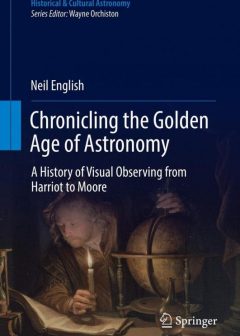Chronicling the Golden Age of Astronomy: A history of visual observing from Harriot to Moore
| By Neil English | Reviewed by John Chuter |
| Springer Nature 2018 | 665 pages |
| Price £159 | ISBN:978-3-319-97707-2 |

This book is one of Springer’s ‘Historical and Cultural Astronomy’ series. It comes with a hefty price tag as a hardback, being slightly cheaper at £127.50 as an e-book. As with other Springer books, individual chapters can be purchased at £23.94, with two-page previews being available on their website. As there are 41 chapters, this would indeed be an expensive exercise if purchased individually.
The question that obviously needs asking is whether it is worth the price of at least the e-book. Neil will be known to many members reading this and he has written several other Springer books, mainly to do with telescopes of various types and eras (principally refractors and reflectors). This magnum opus encapsulates much of Neil’s knowledge from these previous books, by looking at the history of the instruments and the people who used them, from the time of Galileo and Harriot right up to that of Patrick Moore.
Each chapter deals primarily with one individual or theme, but a wealth of other material can be found both in the body of the chapter and in the form of asides. For this reason alone, I recommend buying the whole book. Well known names are to be found, such as Messier, the Herschels, the Earls Rosse, Lassell, Bessel, Smyth, Dawes, the Rev Webb, Denning, the Rev Philips, Peltier, Secchi, Lowell, two Burnhams, Tombaugh, Will Hay, Dobson, Alcock etc. Names which will be less familiar to some, such as Simon Marius, Struve, Nathaniel Green etc are also present. I had not realised that Thomas Jefferson was an astronomer of some repute, or known of the fascinating career of Charles Grover. There are many other such interesting passages in this thoroughly researched book.
There are several chapters devoted entirely to books that Neil considers important milestones in his own astronomical journey and I suspect they are for many other people. Each has detailed notes by Neil as he goes through the chapters of each book. To name two out of five, there is a long chapter devoted to Denning’s Telescopic work for starlight evenings and David Levy’s The quest for comets. This is unusual to find in a book, but actually extremely interesting.
Neil’s love of refractors shines through. Even so he readily acknowledges that reflectors – Dobsonians and other types – can, in certain situations, perform better. The modern enthusiasm for the ‘apo’ (apochromatic refractor) is tackled, with comparisons made between these and other types of refractor. The phrase ‘horses for courses’ springs to mind, as the best type of instrument to use does depend on the task. Everyone will have their own opinions on this, and Neil is entitled to his.
At the start of the review, I asked the question as to whether this book is worth the price. In my view, the answer is a resounding ‘yes’. Neil has skilfully woven an individual path through this ‘golden era’ as he describes it, by recounting in great detail the instruments, books and lives of individuals he considers important to the story. I am confident that many of these will seem equally important to others interested in astronomy.
I am planning on re-reading the book again as soon as I have finished this review. I recommend that you seriously consider reading it too.
John has been a BAA member for over 30 years and is an Archivist of the Association
| The British Astronomical Association supports amateur astronomers around the UK and the rest of the world. Find out more about the BAA or join us. |
